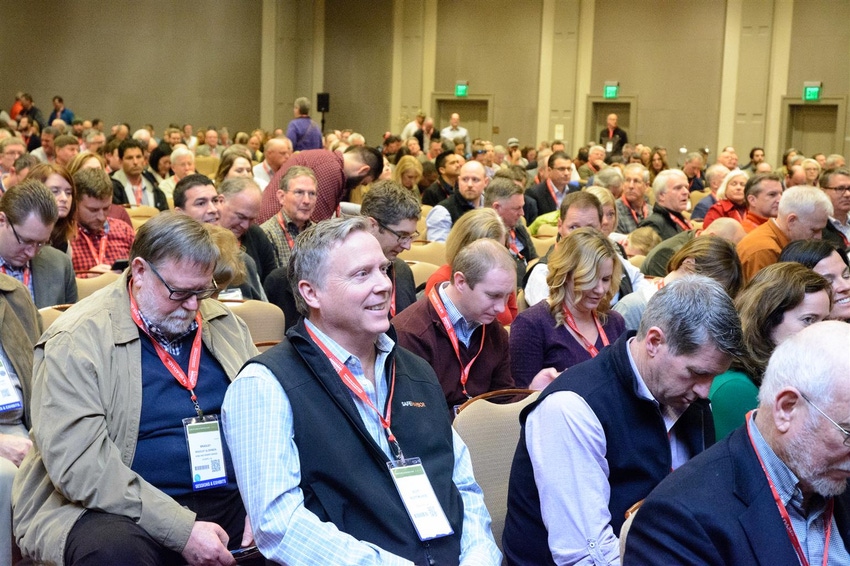
Mechanized wine grape harvest is nothing new for California as at least 85 percent of the state crop and roughly 100 percent of San Joaquin Valley production is hands-free. Finding a way to fully mechanize the rest of the wine-grape production process – that’s the challenge growers continue to face.
Nick Dokoozlian, a plant physiologist with E&J Gallo Company, believes to achieve full mechanization the wine grape industry needs a bottom-up system approach, verses the current adaptations of existing technology to age-old trellising systems.
Dokoozlian spoke at the 2017 Unified Wine & Grape Symposium in Sacramento, Calif. He was on a workshop panel discussing current mechanized practices in wine grape production. He suggests that labor challenges, as important as they are, should not be the driving factor behind mechanization.
Grape and wine quality should come first, which he believes is possible with machines. Data suggest machine harvesting and management can exceed the more labor-intensive hands-on approach.
He estimates that current adoption rates of mechanized practices in California wine grapes range from above 85 percent for harvest to less than 1 percent for cluster removal. About half of the state’s crop is mechanically pre-pruned with a full hand follow-up. Canopy management practices, including leaf removal, shoot thinning and shoot positioning, are well under 50 percent while mechanical hedging occurs on at least 95 percent of the state's crop.
Perhaps less than 10 percent of the state’s wine grape crop is box hedged with little-to-no manual follow-up.
The question remains: how can growers effectively perform various cultural tasks by machine?
Dokoozlian believes the answers may be found in a yet-discovered “integrated systems approach” to growing and producing wine grapes.
“We’ve typically taken existing trellising and training systems and built a machine to fit those, rather than starting from scratch and asking how we’d design a vineyard for full mechanization,” he said. “Don’t look at mechanization as an improvement on labor. See it as a way to improve grape and wine quality.”
Gallo is currently experimenting with mechanical leaf removal; the biggest challenge remains canopy configuration.
Dokoozlian believes mechanized pruning provides a big opportunity for growers and machinery developers.
Central Coast example
Doug Beck of Monterey Pacific, a Salinas Valley vineyard management company, has over a decade of experience with no-touch management of wine grapes in Monterey County. Though not all the vineyards he manages started with mechanized management, most of the new vineyards were established with this idea in mind.
“Our idea was to mechanically prune, spray and harvest with little-to-no hand labor involved,” he said.
Beck says the “writing was on the wall” in the early 2000's regarding the need to mechanize. By 2004, the conversion from vertical shoot positioned-vines (VSP) to box pruning began. Not everyone was on board early with the conversion. Wineries were skeptical of the conversions, not believing the new practices were an acceptable method of producing grapes.
History in California suggested the wineries were right to be skeptical as early attempts to mechanize pruning produced poor-quality fruit, delayed ripening, low soluble solids and poor color, according to Dokoozlian.
“They were worried about some of the wood inside the box ending up in their wineries and were concerned with the level of production,” he continued.
Beck began to collect data as the conversions were made, using large blocks of acreage, the same rootstock, scions and similar soils for comparisons.
Yield data comparing mechanically box pruning with spur pruned vines shows significant improvements in yields favoring mechanical means – at least 50 percent on average. Financial data show returns per acre in Chardonnay and Pinot Noir were at least double under mechanical means. Returns in Cabernet Sauvignon were even greater.
Beck says there was an initial post-conversion bump in yields that receded then stabilized several years into the new practice, though these yields remained higher under the mechanical system.
He recommends “renovating” the box every six-to-seven years by cutting it back even further than normal. Typically he keeps the box cut to about six inches. Keeping the cut close helps keep out deadwood while maintaining good productivity.
Lodi example
Aaron Lange, a fifth-generation farmer and vice president of vineyard operations with Lange Twins in Acampo, Calif., says the hike in California’s minimum wage over the next several years will force more mechanization. He believes their vineyards will be no-touch within the next few years.
He admits that some of the cultural practices will be easier than others to mechanize and that some varieties may not work well under the hands-free approach. Mechanical suckering is one of the current challenges he’s attempting to work through.
Yet another challenge will be mechanizing all sorting during the mechanical harvest, particularly vineyards yielding above 10 tons per acre. The goal, which he is working on, is to adapt machines capable of moving through the harvest process quicker, sort higher volumes of grapes, and reduce the levels of non-grape matter that can make it into bins headed for the winery.
Lange says the tall vine concept, something at least one nursery has developed, will continue to play into how vines are optimized for mechanical management.
About the Author(s)
You May Also Like






